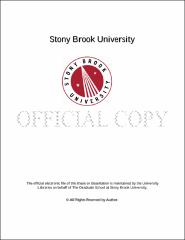| dc.identifier.uri | http://hdl.handle.net/11401/76184 | |
| dc.description.sponsorship | This work is sponsored by the Stony Brook University Graduate School in compliance with the requirements for completion of degree. | en_US |
| dc.format | Monograph | |
| dc.format.medium | Electronic Resource | en_US |
| dc.language.iso | en_US | |
| dc.publisher | The Graduate School, Stony Brook University: Stony Brook, NY. | |
| dc.type | Dissertation | |
| dcterms.abstract | The proliferation of coupling atmospheric ensemble data to models in other related fields requires a priori knowledge of atmospheric ensemble biases specific to the desired application. In that spirit, this dissertation focuses on elucidating atmospheric ensemble model bias and error through a variety of different methods specific to fire weather days (FWDs) over the Northeast United States (NEUS). Other than a handful of studies that use models to predict fire indices for single fire seasons (Mölders 2008, Simpson et al. 2014), an extensive exploration of model performance specific to FWDs has not been attempted. Two unique definitions for FWDs are proposed; one that uses pre-existing fire indices (FWD1) and another from a new statistical fire weather index (FWD2) relating fire occurrence and near-surface meteorological observations. Ensemble model verification reveals FWDs to have warmer (> 1 K), moister (~ 0.4 g kg-1) and less windy (~ 1 m s-1) biases than the climatological average for both FWD1 and FWD2. These biases are not restricted to the near surface but exist through the entirety of the planetary boundary layer (PBL). Furthermore, post-processing methods are more effective when previous FWDs are incorporated into the statistical training, suggesting that model bias could be related to the synoptic flow pattern. An Ensemble Kalman Filter (EnKF) is used to explore the effectiveness of data assimilation during a period of extensive FWDs in April 2012. Model biases develop rapidly on FWDs, consistent with the FWD1 and FWD2 verification. However, the EnKF is effective at removing most biases for temperature, wind speed and specific humidity. Potential sources of error in the parameterized physics of the PBL are explored by rerunning the EnKF with simultaneous state and parameter estimation (SSPE) for two relevant parameters within the ACM2 PBL scheme. SSPE helps to reduce the cool temperature bias near the surface on FWDs, with the variability in parameter estimates exhibiting some relationship to model bias for temperature. This suggests the potential for structural model error within the ACM2 PBL scheme and could lead toward the future development of improved PBL parameterizations. | |
| dcterms.abstract | The proliferation of coupling atmospheric ensemble data to models in other related fields requires a priori knowledge of atmospheric ensemble biases specific to the desired application. In that spirit, this dissertation focuses on elucidating atmospheric ensemble model bias and error through a variety of different methods specific to fire weather days (FWDs) over the Northeast United States (NEUS). Other than a handful of studies that use models to predict fire indices for single fire seasons (Mölders 2008, Simpson et al. 2014), an extensive exploration of model performance specific to FWDs has not been attempted. Two unique definitions for FWDs are proposed; one that uses pre-existing fire indices (FWD1) and another from a new statistical fire weather index (FWD2) relating fire occurrence and near-surface meteorological observations. Ensemble model verification reveals FWDs to have warmer (> 1 K), moister (~ 0.4 g kg-1) and less windy (~ 1 m s-1) biases than the climatological average for both FWD1 and FWD2. These biases are not restricted to the near surface but exist through the entirety of the planetary boundary layer (PBL). Furthermore, post-processing methods are more effective when previous FWDs are incorporated into the statistical training, suggesting that model bias could be related to the synoptic flow pattern. An Ensemble Kalman Filter (EnKF) is used to explore the effectiveness of data assimilation during a period of extensive FWDs in April 2012. Model biases develop rapidly on FWDs, consistent with the FWD1 and FWD2 verification. However, the EnKF is effective at removing most biases for temperature, wind speed and specific humidity. Potential sources of error in the parameterized physics of the PBL are explored by rerunning the EnKF with simultaneous state and parameter estimation (SSPE) for two relevant parameters within the ACM2 PBL scheme. SSPE helps to reduce the cool temperature bias near the surface on FWDs, with the variability in parameter estimates exhibiting some relationship to model bias for temperature. This suggests the potential for structural model error within the ACM2 PBL scheme and could lead toward the future development of improved PBL parameterizations. | |
| dcterms.available | 2017-09-20T16:49:36Z | |
| dcterms.contributor | Colle, Brian A. | en_US |
| dcterms.contributor | Zhang, Minghua | en_US |
| dcterms.contributor | Chang, Edmund | en_US |
| dcterms.contributor | Charney, Joseph | en_US |
| dcterms.contributor | Torn, Ryan. | en_US |
| dcterms.creator | Erickson, Michael Jon | |
| dcterms.dateAccepted | 2017-09-20T16:49:36Z | |
| dcterms.dateSubmitted | 2017-09-20T16:49:36Z | |
| dcterms.description | Department of Marine and Atmospheric Science. | en_US |
| dcterms.extent | 176 pg. | en_US |
| dcterms.format | Application/PDF | en_US |
| dcterms.format | Monograph | |
| dcterms.identifier | http://hdl.handle.net/11401/76184 | |
| dcterms.issued | 2015-12-01 | |
| dcterms.language | en_US | |
| dcterms.provenance | Made available in DSpace on 2017-09-20T16:49:36Z (GMT). No. of bitstreams: 1
Erickson_grad.sunysb_0771E_12355.pdf: 17313628 bytes, checksum: 1ba55e9bc34c59a979cd92a56cd4d103 (MD5)
Previous issue date: 1 | en |
| dcterms.publisher | The Graduate School, Stony Brook University: Stony Brook, NY. | |
| dcterms.subject | Atmospheric sciences | |
| dcterms.subject | Ensemble Kalman Filter, Ensemble modeling, Fire weather, Parameter estimation, post-processing, Weather forecasting | |
| dcterms.title | Exploring Model Error through Post-processing and an Ensemble Kalman Filter on Fire Weather Days | |
| dcterms.type | Dissertation | |

